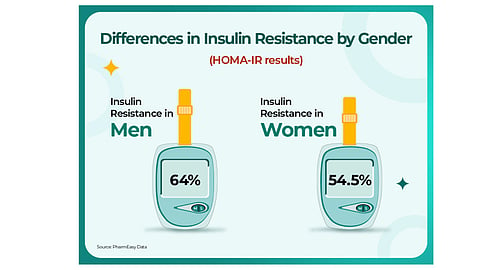

Ahead of World Diabetes Day (14 November), PharmEasy, one of India’s leading healthcare platforms, has released its latest report titled “Diabetes: The Silent Killer Sweeping Across India”. The study, based on data from January 2021 to September 2025, analysed over 4 million diagnostic reports and 19 million medicine orders across 29 states and Union Territories. The findings highlight the growing burden of diabetes in India and the urgent need for early detection and long-term management.
According to the report, nearly 1 in 3 HbA1c test results fall within the diabetic range, while 1 in 4 individuals show signs of prediabetes. Together, this means more than half of those tested show some form of blood sugar irregularity — underscoring the growing scale of diabetes in the country.
“At PharmEasy, we witness every day how early testing and awareness can truly change lives,” said Gaurav Verma, Head of B2C, PharmEasy (API Holdings). “This report is more than data; it is a call for action. 1 in 2 people tested show high blood sugar levels. And there are millions of Indians unaware they are at risk of diabetes. Through accessible testing, continuous monitoring, and medical guidance, we aim to empower every Indian to take charge of their health. Awareness, timely diagnosis, and prevention must move hand in hand to control this silent epidemic.”
A Silent Epidemic Rising Across Ages
PharmEasy’s report reveals that diabetes is increasingly affecting younger adults. Even among those aged under 30, a significant proportion showed high blood sugar levels. The condition peaks after age 60, with 8 in 10 individuals tested falling into the diabetic or prediabetic range. A particularly sharp rise in high blood sugar cases is seen from the age of 30, indicating how early lifestyle and dietary factors start impacting metabolic health.
“Today, one of the most worrying trends in recent years is the changing age profile of diabetes. This significant shift means that complications such as heart disease, kidney issues, and vision loss are occurring decades earlier than before”, said Dr. Animesh Choudhary, MBBS, MD. “Therefore, it’s important to understand that diabetes prevention should begin in childhood by nurturing healthy eating habits, encouraging regular physical activity, and promoting emotional well-being. These early habits go a long way towards reducing the risk of diabetes and related complications later in life.”
The report highlights notable differences between men and women in blood sugar levels and insulin resistance — a major factor contributing to diabetes. About 51.9% of men and 45.43% of women tested had high blood sugar, while 58% of overall users showed insulin resistance, a key early marker of diabetes and metabolic risk. While men are more likely to develop it earlier due to higher abdominal fat accumulation, women experience a sharper rise post-menopause as estrogen protection declines.
Regionally, southern and coastal regions such as Puducherry (63%), Odisha (61%), Tamil Nadu (56%), and Goa (54%) report higher blood sugar levels, while states like Himachal Pradesh (41%) show comparatively lower numbers. This variation reflects the combined influence of diet, lifestyle, and access to healthcare services.
Diabetes medicines now account for one-third of all PharmEasy orders
The growing dependence on chronic medication is reflected in PharmEasy’s data on medicine orders. Diabetes medicines now make up more than one-third of all PharmEasy medicine orders, increasing from 25% in 2021 to 34% in 2024. This reflects how chronic disease management has become a major part of healthcare in India.
PharmEasy’s analysis also reveals the deep connection between diabetes and other organ systems. Among individuals with high blood sugar:
1 in 4 also had thyroid abnormalities, mostly hypothyroidism.
1 in 3 showed signs of liver function issues.
Nearly half had some form of kidney impairment.
About 90% showed deranged lipid profiles, raising their risk of heart disease.
These findings reinforce the importance of routine screening for multiple parameters — including liver, kidney, and heart health — in anyone diagnosed with diabetes.
Early intervention shows positive outcomes
Among those who retested within six months, 22% returned to normal sugar levels, while 61% maintained stable readings. This demonstrates that consistent monitoring, timely medication, and lifestyle changes can significantly improve health outcomes.
The PharmEasy Diabetes Report reaffirms that small, consistent actions can prevent long-term complications. Regular screening, timely treatment, and awareness can help India take a strong step toward reversing the diabetes trend.
Also Read